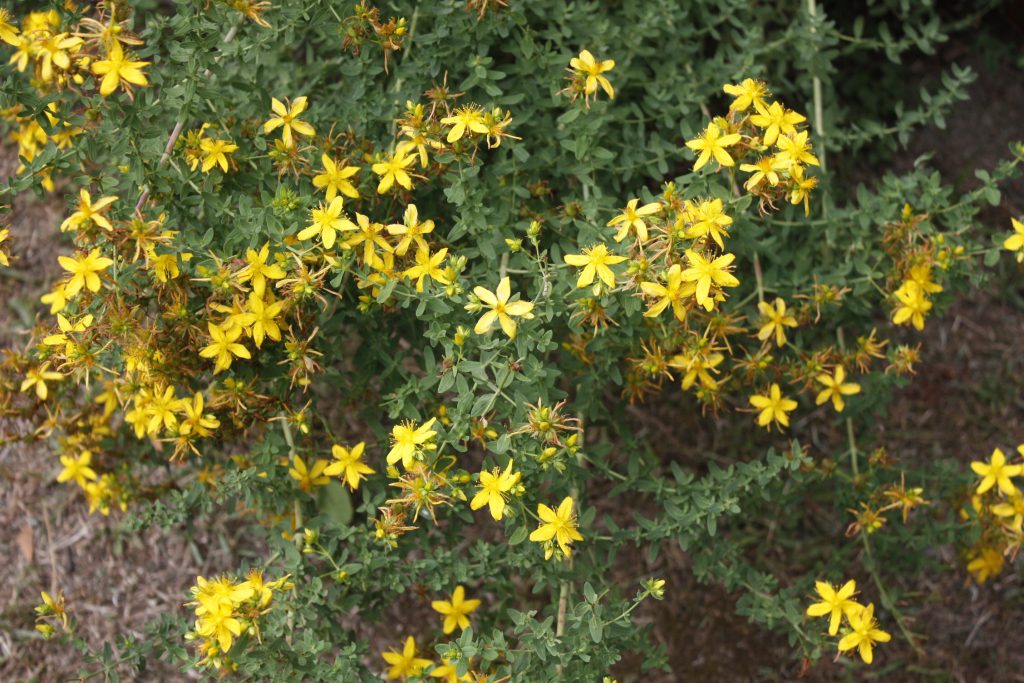Gathering data for this blog to be honest was far from satisfying as I found so much negative information about this wonderful herb, and I wondered how much was based in fact. Then I started to understand that often what they were talking about was pharma created products manufactured from only one or two constituents of the plant. So often, in fact most often, these preparations aren’t St John’s wort as such but hypericin or pseudohyperidin. Just one constituent without all the other 40 or so active constituents that to pharma have no value. To the herbalist this makes no sense. There is a synergy, a completeness and a balance that exists within each medicine plant. I grow St John’s wort outside the door of my whare rongoa and it cheers me up every time I see its sunny yellow flowers, and I often remark how apt, that it is for use when one is feeling depressed or blue. I use it in my balms as it has proven over and over again what an incredible pain reliever it is, especially for damaged nerve endings. It soothes immediately. So many times I wake in the night with a prickle or some injury from gardening throbbing away (My advice is, don’t grow roses!) I spread some of my Everyday Balm (which is rich in St John’s wort) on the injury and before you can count to twenty the throbbing has gone. This is just one application amongst hundreds; burns, sunburn, nappy rash, cuts, grazes, itchy bites, herpes sores, surgical snippings, haemorrhoids, anywhere nerve endings have been damaged it can work it’s miracle. For more details read the full post.
Family; Hypericaceae
Common Names; St John’s Wort, Goatweed, Johnswort, Tipton weed, Klamathweed, Amber
Description; a hardy perennial shrub which grows between 12 -24in high. The plant is covered with small yellow flowers born on the end of the multiple erect stems which are branched in the upper section. The stems carry opposing, stalkless, narrow, oblong leaves which are just over 1/2 in long. The shiny bright yellow flowers have 5 petals and clusters of feathery gold stamens.The yellow-green leaves, are scattered with transparent dots throughout the tissue and occasionally with a few black dots on the lower surface. The translucent dots (oil glands) are obvious when the leaves are held up to the light, giving them a ‘perforated’ appearance, hence the plant’s Latin name.

Parts Used; flowers and leaves
Preparations; extracts, tinctures, homeopathic preparations, washes, tablets, capsules, creams, tea-bags
Habitat; It is native to and relatively widespread throughout the temperate regions of Europe, Western Asia and North Africa.?Although St Johns wort is grown commercially in parts of Europe it is listed as a noxious plant in more than 20 countries world-wide. It is considered toxic and invasive in pasture land and it replaces native plants in their natural habitat. It easily naturalises and the seeds can live in the soil for many years germinating when disturbed. It prefers sunny open locations and dry, poor, rocky soils, although it can also take a hold on the edges of forests or where the tree cover is not dense.
Traditional and Historical Uses; St John’s wort is described in the works of Pliny and Dioscorides who were practising and writing about botany and medicine respectively in the 1st century AD. St Johns wort has been used for centuries to treat wounds and pain. In the middle ages it was used as a physcotherapeutic and to ward off evil. It was also used in exorcisms. In 1525 Paracelsus wrote of it as a treatment for the mad fantasies that can drive people to despair.
Constituents; quinones; hypericin and pseudohyperidin. Flavonoides including; proanthocyanidin, hyperin, biflavone, amentoflavone, quercetin. Terpenoids which contain; essential or volatile oils, xanthones, coumarines. Tannins.
Therapeutic actions; aromatic, astringent, expectorant, nervine, antiseptic, antinflammatory, antiviral, antidepressant, immune supportive.
Medical Uses; ?Evidence from randomised controlled trials has confirmed the efficacy of St John’s wort extracts over placebo in the treatment of mild-to-moderately severe depression. Other randomised controlled studies have provided some evidence that St John’s wort extracts are as effective as some standard antidepressants in mild-to-moderate depression.(Cochrane systemic review, updated Feb 2005).
Contraindications;?Do not combine the oral consumption of this herb with ANY prescribed or self administered medication without consulting your physician, pharmacist or registered herbalist, as this herb has the potential to alter the rate at which many drugs are metabolised.?Do not combine use of this herb with therapeutic ultraviolet light or solarium therapy, as the hypericin content increases photosensitivity to UVA.?Do not use this herb during pregnancy or while breast feeding.
Current Herbal Uses; Externally; bruises, wounds, burns, sunburn, haemorrhoids, varicose veins, herpes sores, shingles, chicken pox, sciatica, nerve pain, arthritis and rheumatic pain.? Internally; mild depression, anxiety, irritability, fatigue, insomnia, digestive catarrh, diarrhoea, ulcers, bronchial catarrh, coughs, menstrual irregularities, urine retention, bedwetting in children.
Garden Applications; Considered an invasive species which has spread through all the temperate region of the world. Can be poisonous to animals causing photosensitivity and blistering of the skin and even death if consumed in large enough quantities.?
Naturally by Trisha Products containing St Johns Wort; Everyday Balm, Baby Bottom Balm, Pile-it-on,Viral Salve, ,Mothers Bottom Balm, Teenage Cream, Warrior Balm